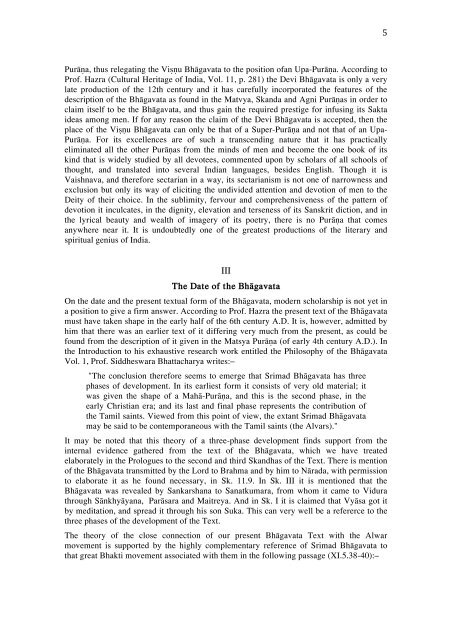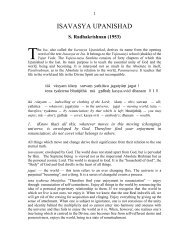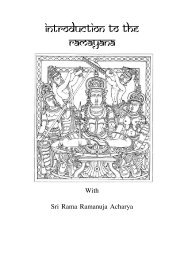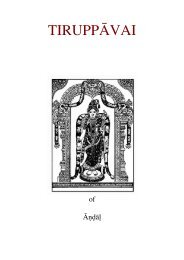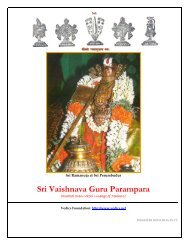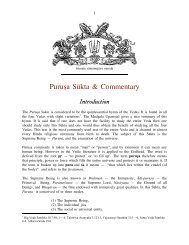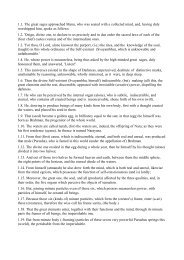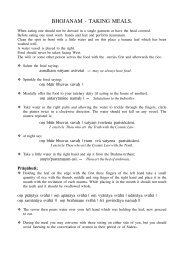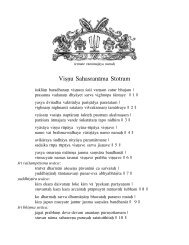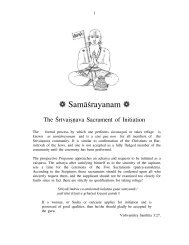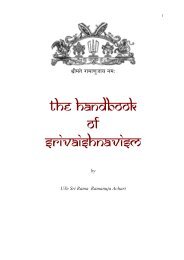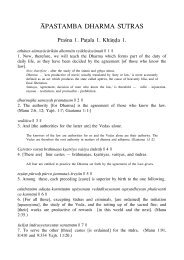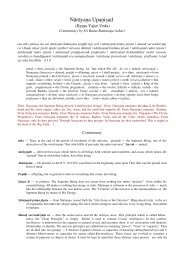4 (6) Vamśa or Genealogy gives descriptive lists of great roval and priestly lines descendedfrom Brahma.(7) Vamśanucharita or Dynastic History deals with rule of distinguished kings and theirdynasties that served the cause of devotion to God and well-being of the universe.(8) Samstha or Dissolution is the description of the four kinds of dissolution of themanifested universe into a finer condition brought about by the influence of Time,Karma, and Guṇas. These dissolutions or Pralayas are the total dissolution of themanifested universe (Prākrita-pralaya), partial dissolution (Naimittika-pralaya), anddaily dissolution in sleep (Nitya-pralaya), besides liberation of mankind (Atyantikapralaya)which implies the dissolution (Pralaya) of all his gross and subtle bodies.This is also called Nirodha or withdrawal of all manifestations, and includes Mukti orLiberation.(9) Hetu or Purpose is the discussion of the root cause and significance of all creativeactivity. It concerns the Jīva (the individual Self), the product of Avidya (ignorance)and its ensuing effects of desire and Karma. All creative activity is to confer on Jīvasthe fruits of their Karmas and ultimately redeem them from ignorance and rebirth. Sosubjects like the nature of the Jīva, of the ways of his redemption, the purpose ofcreation etc., will come under this topic. It is also described by the expression titi. orKarmic tendencies of Jīvas.(10) Apāsraya or Ultimate Support. This is God who is the Ultimate Being and the Supportof all relative supports. In film and by His will all the above-mertioned events andprecesses of the relative world take place. It is to bring man into an adequateconception of His excellences and to generate in him devotion to the Lord, that all theother themes mentioned before are discussed in the Purāṇas. There will be foundscattered all over the Purāṇas considerable matter relating to history, geography,astronomy, natural sciences, sociology, etc., as understood in ancient days. Theobject of such accounts is not to give us some information claiming to be factual as inthe case of the modern studies of such subjects, but to engender in us a feeling that allfunctions of Nature and of human and divine agencies are to proclaim the glory ofthe Supreme and thus generate in us a sense of His omnipotence, omniscience andredeeming love.The Brahma-vaivarta Purāṇa, a much later work, recasts the list as follows: Srishti (primarycreation); Visrishti (secondary creation), Sthiti (maintenance of the worlds); Palana(protection and redemption of Jīvas); Karma-vasana (latent tendencies of work),Manvantara (accounts of the Manus). Pralaya-varnana (accounts of final dissolution of theworlds); Mokṣa-nirupana (dissertation on Mokṣa or liberation): Hari-kirtana (discourseson Hari or God), and Deva-kirtana (discourses on Deities).The Brahma- vaivarta is one of the latest of Purāṇas, having evolved from about the 8th tothe 16th century A.D., and its elimination of genealogies of Rishis and Kings and additionof novel features are the result of the changed times in which Rishis and ancient dynastiesof kings had ceased to be of importance.The Place of the Bhāgavata among the PurāṇasWhat exactly is the place of the Bhāgavata Purāṇa in this vast body of religious literature?It will be noted that it is included in the traditional list of eighteen Mahā-Purāṇas, but thishas been questioned by the Devi Bhāgavata, which claims to be the Bhāgavata-Mahā-
5 Purāṇa, thus relegating the Viṣṇu Bhāgavata to the position ofan Upa-Purāṇa. According toProf. Hazra (Cultural Heritage of India, Vol. 11, p. 281) the Devi Bhāgavata is only a verylate production of the 12th century and it has carefully incorporated the features of thedescription of the Bhāgavata as found in the Matvya, Skanda and Agni Purāṇas in order toclaim itself to be the Bhāgavata, and thus gain the required prestige for infusing its Saktaideas among men. If for any reason the claim of the Devi Bhāgavata is accepted, then theplace of the Viṣṇu Bhāgavata can only be that of a Super-Purāṇa and not that of an Upa-Purāṇa. For its excellences are of such a transcending nature that it has practicallyeliminated all the other Purāṇas from the minds of men and become the one book of itskind that is widely studied by all devotees, commented upon by scholars of all schools ofthought, and translated into several Indian languages, besides English. Though it isVaishnava, and therefore sectarian in a way, its sectarianism is not one of narrowness andexclusion but only its way of eliciting the undivided attention and devotion of men to theDeity of their choice. In the sublimity, fervour and comprehensiveness of the pattern ofdevotion it inculcates, in the dignity, elevation and terseness of its Sanskrit diction, and inthe lyrical beauty and wealth of imagery of its poetry, there is no Purāṇa that comesanywhere near it. It is undoubtedly one of the greatest productions of the literary andspiritual genius of India.IIIThe Date of the BhāgavataOn the date and the present textual form of the Bhāgavata, modern scholarship is not yet ina position to give a firm answer. According to Prof. Hazra the present text of the Bhāgavatamust have taken shape in the early half of the 6th century A.D. It is, however, admitted byhim that there was an earlier text of it differing very much from the present, as could befound from the description of it given in the Matsya Purāṇa (of early 4th century A.D.). Inthe Introduction to his exhaustive research work entitled the Philosophy of the BhāgavataVol. 1, Prof. Siddheswara Bhattacharya writes:–"The conclusion therefore seems to emerge that Srimad Bhāgavata has threephases of development. In its earliest form it consists of very old material; itwas given the shape of a Mahā-Purāṇa, and this is the second phase, in theearly Christian era; and its last and final phase represents the contribution ofthe Tamil saints. Viewed from this point of view, the extant Srimad Bhāgavatamay be said to be contemporaneous with the Tamil saints (the Alvars)."It may be noted that this theory of a three-phase development finds support from theinternal evidence gathered from the text of the Bhāgavata, which we have treatedelaborately in the Prologues to the second and third <strong>Skandha</strong>s of the Text. There is mentionof the Bhāgavata transmitted by the Lord to Brahma and by him to Nārada, with permissionto elaborate it as he found necessary, in Sk. 11.9. In Sk. III it is mentioned that theBhāgavata was revealed by Sankarshana to Sanatkumara, from whom it came to Vidurathrough Sānkhyāyana, Parāsara and Maitreya. And in Sk. I it is claimed that Vyāsa got itby meditation, and spread it through his son Suka. This can very well be a refererce to thethree phases of the development of the Text.The theory of the close connection of our present Bhāgavata Text with the Alwarmovement is supported by the highly complementary reference of Srimad Bhāgavata tothat great Bhakti movement associated with them in the following passage (XI.5.38-40):–
- Page 3: 3 by turn, as it were, thus display
- Page 8 and 9: 8 There is, however an anomalous ci
- Page 11: 11 Viṣṇu conception, and that i
- Page 18 and 19: 18 Cosmic History versus Modern Wor
- Page 20 and 21: 20 categories, the succeeding from
- Page 22 and 23: 22 the lie to the modern theory tha
- Page 24 and 25: 24 much vaunted historicity of Chri
- Page 26 and 27: 26 In an Introduction to a Text lik
- Page 28 and 29: 28 connoisseur of the sentiment of
- Page 30 and 31: 30 the Sattvika manifestation of V
- Page 32 and 33: 32 There is no Limit to the Number
- Page 34 and 35: 34 and divided by the good and kind
- Page 36 and 37: 36 joyous memory of His service, an
- Page 38 and 39: 38 asunder by roaming elephant herd
- Page 40 and 41: 40 means by which the darkness of i
- Page 42 and 43: 42 Suta said:- 40. Still Arjuna did
- Page 44 and 45: 44 22. Salutations to the One havin
- Page 46 and 47: 46 sorrow at, the death of all frie
- Page 48 and 49: 48 His mind was free from all sinfu
- Page 50 and 51: 50 11-12. Spiritual aspirants who h
- Page 52 and 53: 52 ever satisfied with his own blis
- Page 54 and 55:
54 Skandha 1: Chapter 12THE BIRTH O
- Page 56 and 57:
56 and returned to Hastinapura, hav
- Page 58 and 59:
58 them at His will. 41. Just as a
- Page 60 and 61:
60 Arjuna's Return in utter Distres
- Page 62 and 63:
62 sought by Indra and the Devas fo
- Page 64 and 65:
64 that state of absolute purity, w
- Page 66:
66 subject to any diminution in K
- Page 69 and 70:
69 degeneration. 6. No doubt Kali,
- Page 71 and 72:
71 connected with these crimes. Man
- Page 73:
73 Arrival of Sri Suka (25-40)25. W


